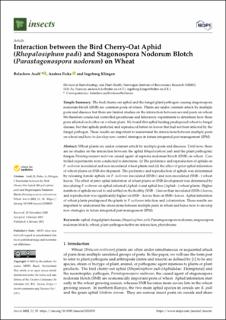| dc.contributor.author | Asalf, Belachew | |
| dc.contributor.author | Ficke, Andrea | |
| dc.contributor.author | Klingen, Ingeborg | |
| dc.date.accessioned | 2021-10-14T11:29:21Z | |
| dc.date.available | 2021-10-14T11:29:21Z | |
| dc.date.created | 2021-02-19T15:04:08Z | |
| dc.date.issued | 2021-01-06 | |
| dc.identifier.citation | Insects. 2021, 12 (1), . | en_US |
| dc.identifier.issn | 2075-4450 | |
| dc.identifier.uri | https://hdl.handle.net/11250/2822998 | |
| dc.description.abstract | Simple Summary The bird cherry-oat aphid and the fungal plant pathogen causing stagonospora nodorum blotch (SNB) are common pests of wheat. Plants are under constant attack by multiple pests and diseases but there are limited studies on the interaction between several pests on wheat. We therefore conducted controlled greenhouse and laboratory experiments to determine how these pests affected each other on a wheat plant. We found that aphid feeding predisposed wheat to fungal disease, but that aphids preferred and reproduced better on leaves that had not been infected by the fungal pathogen. These results are important to understand the interactions between multiple pests on wheat and how to develop new control strategies in future integrated pest management (IPM). Abstract Wheat plants are under constant attack by multiple pests and diseases. Until now, there are no studies on the interaction between the aphid Rhopalosiphum padi and the plant pathogenic fungus Parastagonospora nodorum causal agent of septoria nodorum blotch (SNB) on wheat. Controlled experiments were conducted to determine: (i) The preference and reproduction of aphids on P. nodorum inoculated and non-inoculated wheat plants and (ii) the effect of prior aphid infestation of wheat plants on SNB development. The preference and reproduction of aphids was determined by releasing female aphids on P. nodorum inoculated (SNB+) and non-inoculated (SNB−) wheat leaves. The effect of prior aphid infestation of wheat plants on SNB development was determined by inoculating P. nodorum on aphid-infested (Aphid+) and aphid free (Aphid−) wheat plants. Higher numbers of aphids moved to and settled on the healthy (SNB−) leaves than inoculated (SNB+) leaves, and reproduction was significantly higher on SNB− leaves than on SNB+ leaves. Aphid infestation of wheat plants predisposed the plants to P. nodorum infection and colonization. These results are important to understand the interactions between multiple pests in wheat and hence how to develop new strategies in future integrated pest management (IPM). | en_US |
| dc.language.iso | eng | en_US |
| dc.publisher | MDPI, Basel, Switzerland | en_US |
| dc.rights | Navngivelse 4.0 Internasjonal | * |
| dc.rights.uri | http://creativecommons.org/licenses/by/4.0/deed.no | * |
| dc.title | Interaction between the Bird Cherry-Oat Aphid (Rhopalosiphum padi) and Stagonospora Nodorum Blotch (Parastagonospora nodorum) on Wheat | en_US |
| dc.type | Peer reviewed | en_US |
| dc.type | Journal article | en_US |
| dc.description.version | publishedVersion | en_US |
| dc.rights.holder | © 2021 by the authors | en_US |
| dc.source.pagenumber | 13 | en_US |
| dc.source.volume | 12 | en_US |
| dc.source.journal | Insects | en_US |
| dc.source.issue | 1 | en_US |
| dc.identifier.doi | 10.3390/insects12010035 | |
| dc.identifier.cristin | 1891854 | |
| dc.relation.project | Norges forskningsråd: 244526 | en_US |
| dc.source.articlenumber | 35 | en_US |
| cristin.ispublished | true | |
| cristin.fulltext | original | |
| cristin.qualitycode | 1 | |

